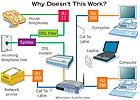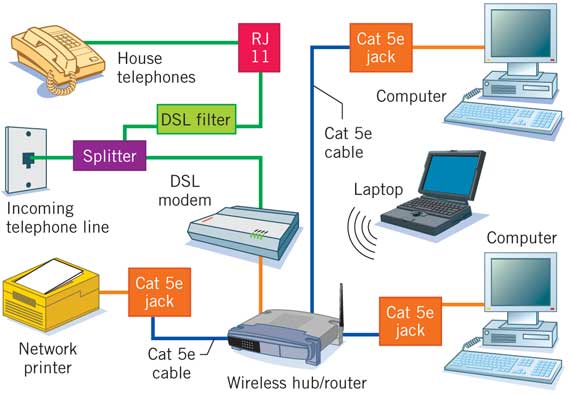
-
All wireless network devices are interchangeable.
a. True
b. False
-
What type of cable should be used for a 100 Mbps Ethernet data network?
a. 18/2
b. Cat 3
c. Cat 5e
d. Any of the above
e. None of the above
-
What type of cable should be used for speakers?
a. 14/2
b. RG-6 quad shield
c. Cat 5e
d. Any of the above
e. None of the above
-
What type of cable should be used for satellite TV systems?
a. RG-59U
b. RG-6 quad shield
c. RG-58U
d. Any of the above
e. None of the above
-
It is possible to use existing electrical outlets and cable to establish a data network.
a. True
b. False
-
What benefits does home networking provide?
a. Ability to share a broadband Internet connection
b. Ability to share a printer
c. Ability to share files among computers
d. All of the above
e. None of the above
-
DHCP is a protocol that allows each computer to obtain a unique IP address from a server on the network.
a. True
b. False
-
Crosstalk is the coupling of unwanted signals from one pair to another pair within a cable.
a. True
b. False
-
What are the benefits of fiber-optic cable?
a. High bandwidth
b. Small size
c. Immunity from electromagnetic interference
d. All of the above
e. None of the above
-
Hubs and switches are identical devices.
a. True
b. False
-
What frequency do 802.11g wireless devices utilize?
a. 2.4 GHz
b. 5 GHz
c. 300 MHz
d. 900 MHz
-
The core of a multimode fiber-optic cable is smaller than the core of a single-mode fiber-optic cable
a. True
b. False
-
You can properly test Cat 5e cables using a standard volt ohmmeter (VOM).
a. True
b. False
-
All data network cables are shielded.
a. True
b. False
-
What is the maximum data rate for an 802.11g wireless network?
a. 1 Mbps
b. 5 Mbps
c. 54 Mbps
d. 100 Mbps

What’s Wrong with This?
Wally `Larman installed a prewire for a 100 Mbps Ethernet data network. He ran Cat 5e cable from the router location to each computer/printer location and installed RJ-38X jacks since they have eight pins, as shown in this diagram. Wally carefully tested the cables with a cable tester and found no problems, but when the network installer arrived, he was not satisfied. Can you see what Wally did wrong and what he must do to correct the problem?5-Minute Tech Quiz Answers
- b — Wireless devices are manufactured to meet various wireless standards such as 802.11a, 802.11b, 802.11g or 802.11n. You must use devices that are compatible with the wireless router.
- c — You must use a Cat 5e or better cable for 100 Mbps Ethernet networks. 18/2 is OK for power, and Cat 3 can be used for analog telephone sets.
- a — The AWG of the speaker wire should be determined by the length of the cable runs, but typically 14/2 is acceptable for reasonable runs.
- b — Due to the frequencies used, satellite providers recommend that you run RG-6, not RG-58/59.
- a
- d
- a — DHCP (Dynamic Host Configuration Protocol) is a protocol in which a computer or other device can obtain an IP address and other network configuration data from a server on a network.
- a
- d
- b
- a
- b — Multimode fiber typically has a core diameter of 50 to 100um. Single-mode fiber has a core typically of 8 um.
- b — Although a volt ohmmeter (VOM) can test for opens and shorts, to test quickly for reversed/crossed pairs or miswiring, a cable tester is the better choice.
- b
- c — The actual data rate will vary depending upon many factors, such as distance and interference.
